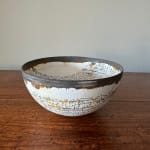





Helen Carnac
Up, Across, Along Vessel, 2022
Vitreous enamel on steel
9 x 17cm
CF1103
Copyright The Artist
Further images
We usually see enamel on pieces of jewellery and trinkets, giving them a smooth, glossy and brightly coloured finish, but the material has a more prosaic use too. From the...
We usually see enamel on pieces of jewellery and trinkets, giving them a smooth, glossy and brightly coloured finish, but the material has a more prosaic use too. From the 18th century, the vitreous enamel process (ground glass and porcelain fused to metal at a high temperature) became used industrially to finish pots and pans, sinks and baths, and even cookers and washing machines, thanks to its tough and durable nature.
Artist Helen Carnac first encountered vitreous enamel as a student, seeing the London Underground signage at Aldgate East (made around 1908).
“I would always walk by and touch the surface of the signs and look at the edges, where the layers of enamel were sometimes chipped. A combination of coldness and glassiness led me to understand that this material was glass on a steel substrate, and this opened up a curiosity in the material and its production for me.”
Reacting against our expectation of the material to be inert and clinical, she experiments with sgraffito techniques, scratching marks onto the surfaces of her bowls, panels and other artworks to encourage rust and oxidisation.
Brought up in rural South Wales, Helen spent her childhood surrounded by the demise of the nearby mining, farming and steel making industries.
“I have spent much time walking in these post-industrial landscapes, interested in the micro examination of surface, patina and decay.”
The artist’s creative practice involves long walks as research trips, taking numerous photographs, making drawings and collecting artefacts that help give her finished pieces a sense of ‘time and presence’.
Artist Helen Carnac first encountered vitreous enamel as a student, seeing the London Underground signage at Aldgate East (made around 1908).
“I would always walk by and touch the surface of the signs and look at the edges, where the layers of enamel were sometimes chipped. A combination of coldness and glassiness led me to understand that this material was glass on a steel substrate, and this opened up a curiosity in the material and its production for me.”
Reacting against our expectation of the material to be inert and clinical, she experiments with sgraffito techniques, scratching marks onto the surfaces of her bowls, panels and other artworks to encourage rust and oxidisation.
Brought up in rural South Wales, Helen spent her childhood surrounded by the demise of the nearby mining, farming and steel making industries.
“I have spent much time walking in these post-industrial landscapes, interested in the micro examination of surface, patina and decay.”
The artist’s creative practice involves long walks as research trips, taking numerous photographs, making drawings and collecting artefacts that help give her finished pieces a sense of ‘time and presence’.
Exhibitions
Selected Exhibitions
Winter - the weakening eye of day - Cromwell Place with Cavaliero Finn, November 2023





